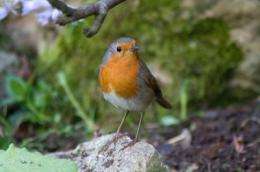Seeing red: Decoding the hidden information on robins' feathers

Red breasted robins are a classic symbol of the winter months and have adorned Christmas cards for over a century. Ornithologists studying the feathers of the European robin (Erithacus rubecula) have discovered that the red breast reveals more than simply the species of the owner. The findings, published in Ibis, reveal how the famous red breast varies in size and colouration over ages and sexes, suggesting it may be used to communicate features of the owner to other robins.
The research, led by Dr. Roger Jovani from Estación Biológica de Doñana (Spanish National Research Council, CSIC) in Sevilla, follows in the footsteps of renowned ornithologist David Lack, who studied the behaviour of robins in the 1940's. Lack recorded that a violent hen robin attacked a headless stuffed specimen, leading him to discover that it was the red breast which triggered the aggression.
"After more than six decades, we still have a very limited understanding of the important information robins may communicate through the red breast," said Dr Jovani. "Our study sought to understand how its size differs according to age and sex. Also, we studied the role of the grey fringe that frames the robin's red breast, which has been largely overlooked."
The research, carried out at a pine forest north of the Catalan city of Barcelona focused on the sexual dimorphism and trends in red breast size when robins age. Juvenile robins which have recently left the nest wear a brownish plumage, lacking the distinctive red breast. This is achieved some months later during their first summer moult.
The robin moults again in the second summer of life and this, the team predicted, leads to a larger red breast. As both male and female robins defend territory all year round the team expected that both sexes would have similarly sized red breasts and grey fringes.
The team's results revealed unknown patterns of variation in the red breast and grey fringe of the robin. The size of the red breast was found to increase from the first to the second year in both males and females. However, old males showed consistently larger badges than old females after their second year.
This surprising variation across sexes and over time suggests that the red breast may convey information of sex, age or related condition-dependent traits. Moreover, researchers applied computer models that take into account environmental luminosity and bird sensitivity to study the colour contrast between feathers as seen by a robin. They found that the grey fringe, which increases in age, highlights the perimeter of the red breast.
"Our study is a first step in understanding the role of the red breast and the grey frame in the life of robins," concluded Jovani. "Further studies will likely show more surprises on the role of the redbreast and its grey frame on resolving territorial contests and mating decisions in robins".
Provided by Wiley



















